
Chiasmia is a genus of moths in the family Geometridae. It was described by Jacob Hübner in 1823.

Ozola is a genus of moths in the family Geometridae first described by Francis Walker in 1861.

Semiothisa is a genus of moths in the family Geometridae. It was erected by Jacob Hübner in 1818.
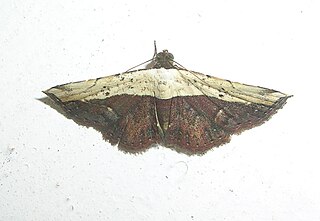
Oruza divisa is a species of moth of the family Erebidae first described by Francis Walker in 1862. It is found in Asia, including Hong Kong, Sri Lanka, Sulawesi, Taiwan, Japan and in Africa south of the Sahara, including Indian Ocean islands.

Loryma recusata is a species of snout moth in the genus Loryma. It was described by Francis Walker in 1863 and is known from Taiwan, Indonesia, Sri Lanka, India, Thailand, western Malaysia and New Guinea. It has also been recorded from northern Australia and South Africa.
Phricanthes flexilineana is a species of moth of the family Tortricidae first described by Francis Walker in 1863. The species was described from Sri Lanka, northern Queensland in Australia and the Seychelles, but has a much wider range, which includes Madagascar, India, Indonesia, Myanmar, New Guinea, the Philippines and Taiwan. It is also widely distributed in the tropical parts of North and South America.
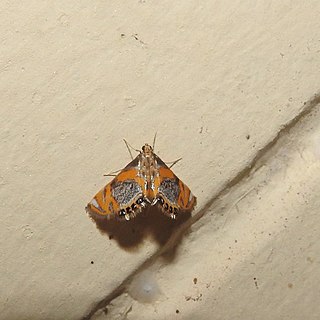
Nymphicula blandialis is a moth in the family Crambidae. It was described by Francis Walker in 1859. It is found in southern China, India, Malaysia, Sri Lanka, Taiwan, Japan, the Democratic Republic of the Congo, Ghana, Guinea, Mozambique, Nigeria, South Africa and Uganda.

Glyphodes pyloalis, the lesser mulberry snout moth, lesser mulberry pyralid or beautiful glyphodes moth, is a moth in the family Crambidae. It was described by Francis Walker in 1859. It is found in Iran, China, Japan, India, Indonesia (Sumatra), Sri Lanka, Taiwan, the Democratic Republic of the Congo, Equatorial Guinea, Mozambique and North America, where it has been recorded from Florida, Maryland, North Carolina, South Carolina and Virginia.

Nacoleia charesalis is a moth in the family Crambidae. It was described by Francis Walker in 1859. It is found in Australia, India, Sri Lanka, Borneo, Sumbawa, the Philippines, Singapore, Thailand, Japan, Taiwan and on the Seychelles.

Ischnurges gratiosalis is a moth in the family Crambidae. It was described by Francis Walker in 1859. It is found in Sri Lanka, China, Taiwan and India and on Borneo and the Maldives.

Patania sabinusalis is a species of moth in the family Crambidae. It was described by Francis Walker in 1859. It is found in Australia, Cameroon, the Democratic Republic of the Congo, Kenya, the Seychelles, Somalia, Uganda, Zambia, Sri Lanka, India, Borneo, Java, Fiji, New Guinea, Samoa, the Solomon Islands, Taiwan and Japan.

Pycnarmon meritalis is a moth in the family Crambidae. It was described by Francis Walker in 1859. It is found in Democratic Republic of the Congo, South Africa, Australia, China, Sri Lanka, India, Indonesia, Taiwan and Japan.
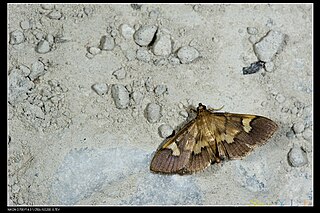
Syngamia falsidicalis is a moth in the family Crambidae. It was described by Francis Walker in 1859. It is found in the Democratic Republic of the Congo (Equateur), Zimbabwe, China, Sri Lanka and Taiwan.
Syngamia latimarginalis is a moth in the family Crambidae. It was described by Francis Walker in 1859. It is found in Sri Lanka, India, Myanmar, Indonesia (Java), Taiwan, the Democratic Republic of the Congo (Katanga), Equatorial Guinea, Kenya and Mozambique.
Brachiolia egenella is a species of moth of the family Tortricidae first described by Francis Walker in 1864. It is found in Sri Lanka, India, South Africa and on the Comoros and Mauritius.
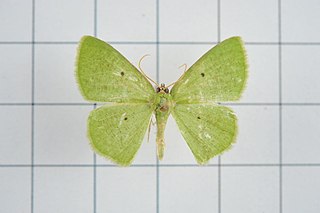
Aplochlora vivilaca is a moth of the family Geometridae first described by Francis Walker in 1861. It is found in Sri Lanka, Indian subregion, Taiwan, Borneo and Sulawesi.

Calletaera postvittata is a moth of the family Geometridae first described by Francis Walker in 1861. It is found in the Indian sub-region, Sri Lanka, Taiwan, and Sundaland.

Eucyclodes semialba is a moth of the family Geometridae first described by Francis Walker in 1861. It is found in Sri Lanka, the north-east Himalayas of India, Myanmar and Sundaland.
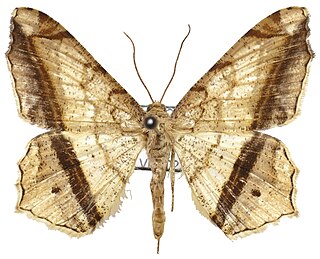
Semiothisa ozararia, is a moth of the family Geometridae first described by Francis Walker in 1860. It is found in the Indian subregion, Sri Lanka, Taiwan, Borneo, Sumatra and Java.
Ctenoplusia fracta is a moth of the family Noctuidae first described by Francis Walker in 1858.
















